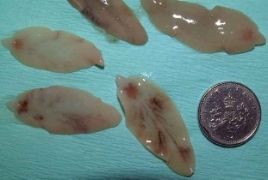- Home
- News & Industry
- HCC Warns: Beware High Risk Season For Costly Liver Fluke
HCC Warns: Beware High Risk Season For Costly Liver Fluke

Autumn is the high risk season for liver fluke - so it’s time to plan on-farm parasite management to avoid unwanted costs of up to £30 per infected animal, advises Hybu Cig Cymru - Meat Promotion Wales’ industry development team.
“Late summer and early autumn are traditionally known as a high-risk-period for liver fluke and a key time for Welsh beef farmers to be proactive in terms of liver fluke management,” said Lynfa Davies, HCC’s Technical Development Executive.
“The industry steering group for COWS (Control of Worms Sustainably) advises that implementing a parasite management plan this autumn, will help farmers avoid such production and economic losses.”
Food Standards Agency (FSA) data, collated from abattoirs across Great Britain over the last 12 months, reports that one in five cattle livers were damaged by fluke. This represents a significant loss in productivity across the sector and decreased returns for producers, according to Dr Andy Forbes, COWS technical representative and honorary professor at the University of Glasgow’s School of Veterinary Medicine.
“The data highlights that of the 21 per cent condemned livers, the highest incidences are being seen between September and May, with a significant peak in January. As it takes two to three months for the liver fluke to develop into adult fluke inside cattle, the peak found in livers in January, is a likely result of infections acquired in the autumn,” said Dr Forbes.
Prior to treating beef cattle for fluke, Dr Forbes advises that it’s important to focus on precisely what you are trying to achieve. “There are two key reasons for a fluke treatment at or after housing.
“Firstly, removing fluke burdens will help cattle perform well over winter and achieve their potential in terms of growth and productivity. Secondly, if cattle are to graze on-farm the following year, effective flukicide treatment over winter will ensure that the cattle are not shedding fluke eggs in their dung onto pasture after turnout and will not contaminate pastures.
“Once the goal of treatment is clear, the choice of when to treat and with what is based on factors including whether resistance to any flukicide has previously been diagnosed on-farm, the class of cattle being treated and consideration of meat and milk withdrawal periods. Speak to your vet or SQP about implementing a parasite management plan that is best suited to your system,” said Dr. Forbes.
COWS best practice guidelines recommend that when worming cattle it is vital that each dose is accurately calculated before treating. “This is only possible if you know the exact weight of cattle. Judging by eye is notoriously difficult and inaccurate so ensure you use a weigh crate or a weigh band,” says Dr Forbes.
“It is also important to check that dosing guns are calibrated properly and if necessary faulty equipment replaced to ensure treatments are accurate as well as cost effective. Check withdrawal periods and follow the manufacturer’s guidelines on the product data-sheet.
“The weather in summer can determine the risk of fluke in the autumn as the snail hosts do not do well in dry conditions. It may be that liver fluke challenge is lower in some parts of the country, but if it was warm and wet in June and July, the challenge could be high.
“Local knowledge is useful in assessing the risk in your region so speak to your vet or Suitably Qualified Person (SQP) and then plan ahead to minimise risk of liver fluke infections having an impact on-farm. It’s also worth noting there will be differences when it comes to managing liver fluke in sheep.
“There is no one size fits all approach to managing liver fluke on-farm, but implementing a parasite management plan based on recommendations from your vet or SQP, and following the COWS best practice guidelines will help reduce the economic and production losses associated with liver fluke,” says Dr Forbes.

